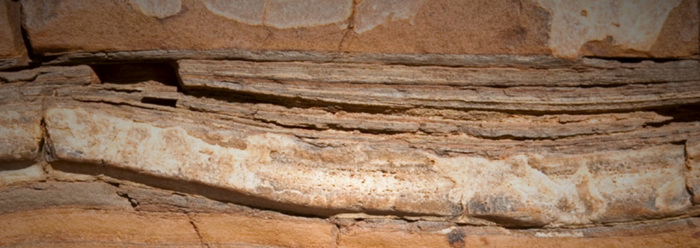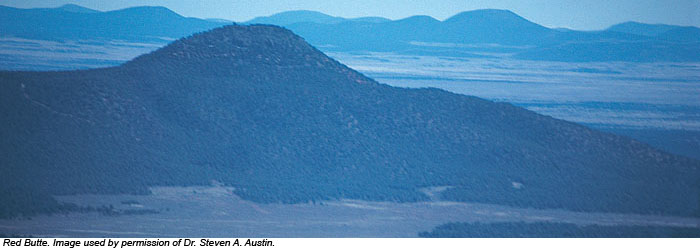Advocates of vertical evolution think their beliefs are as factual as the earth orbiting the sun. However in 2015, science again shows something quite different.
Recent paleontological discoveries all point to minor variation and stasis—or standing still. Macroevolution is the holy grail of the secular faithful, but it continues to elude observation in sedimentary rocks and in the laboratory. 2015 is no different with evolutionists surprised to find creatures allegedly "millions of years old" that are just the same as their modern counterparts.
Scientists discovered a supposed 150-million-year-old fossilized crab larva in Germany this year. The find surprised secular scientists because it "possesses a very modern morphology, indistinguishable from many crab larvae living today."1 Creationists are hardly amazed, seeing that God created crabs as crabs, as He did with all the other arthropods.2 Evolutionists disagree, but admit in the same article that "the early evolution of crabs is still very incompletely known."1
On January 21, 2015 the news broke—an Australian fisherman hooked a "living fossil." Called the frilled (or frill) shark (genus Chlamydoselachus, belonging to Order Hexanchiformes), this creature was thought to be 80 million years old.3 It looks mighty frightening, but is it truly "prehistoric" and somehow linked to shark evolution? Today, there are five extant (living) species of hexanchiforms, including the deep-water cow shark.
Virtually all the proposed transitional sharks are easily recognized as sharks, showing only that a wide variety of sharks and other cartilaginous fishes existed in the past, just as they do today.4,5 The frilled shark has always been a shark.
Snakes are also the subject of a recent unexpected discovery that supposedly pushes their first appearance back an additional 65 million years.6 Evolutionists were shocked at the discovery of four snake fossils, the oldest (Eophis underwoodi) dating back to "167 million years" by evolutionary dating. Prior to these discoveries the oldest snake fossil was a mere "102 million years old." Fossils of transitional snake-like creatures do not exist. There are only questionable theories and conjecture.
What is the origin of snakes?
- "Unfortunately, the fossil history of the snakes is very fragmentary, so that it is necessary to infer much of their evolution from the comparative anatomy of modern forms."7
- "The origin of the snakes is still an unsolved problem."8
- "Zoologists debate the evolutionary origin of the snakes."9
- Even as recently as this year 2015, evolutionists say, "The debate is far from resolved."10
Is it any wonder the theme of no real evidence of evolutionary change is seen throughout another 2015 article regarding these same snake fossils? "The snakes in these groups 'are still very much snakes, there is no question about the affinity of these living forms.'"11 The debate regarding the origin of snakes continues.
A University of California Berkley graduate student recently discovered two beautiful new species of peacock spiders (genus Maratus) in southeast Queensland, Australia.12 It's not surprising these creatures have been called "peacock spiders" with the black, red, and blue coloring of the males. They are also designed with white hairs that can actually fold. Such colorful designs are used for display during mating.
An evolutionary entomologist stated the peacock spider group is more varied than previously thought. Non-Darwinists wholly agree—there is much variation within the created spider kind. Spider origin has been much debated by secular zoologists. They don't know what the closest evolutionary relatives of spiders are. Indeed, when it comes to their origin, two evolutionists stated, "Most zoologists believe that arachnids arose from the eurypterids and were early terrestrial inhabitants."13
One evolutionist reported that "spider gene study reveals tangled evolution."14 Tangled indeed. Creationists maintain spiders were created as spiders like Scripture and science shows. Wherever they are found—whether in the fossil record or crawling across your living room floor—they always display eight legs, remarkable eyesight, and—as creationists predict—are 100% spiders.
This year, scientists from the Natural History Museum of Utah discovered fossils of pig-snouted turtles in southern Utah.15 This strange-looking, two-foot-long turtle lived alongside dinosaurs about "76 million years ago" according to evolutionists. Not surprisingly, there are pig-snouted turtles (Carettochelys insculpta)—also known as Fly River turtles—alive and well today. They are a species of freshwater turtle native to southern New Guinea and northern Australia. Bizarre or not, turtles have always been turtles.
The same goes for the large sea turtle. In 2015, scientists found the world's oldest known fossil sea turtle (Desmatochelys padillai).16 The fossilized reptile is supposedly at least 120 million years old—which makes it about 25 million years older than the previously known oldest specimen. Not surprisingly, the preserved skeleton of this sea turtle "shows all of the characteristic traits of modern marine turtles."
As the year 2015 draws to a close, the evolutionary community is no closer to determining the origin of those majestic missionary lizards, the dinosaurs. They stand, not as proof of evolution, but the product of God's creative design. Digging down into the sedimentary rock units reveals the sudden appearance of dinosaurs in the fossil record—as predicted by creation scientists. But their origin is still a contentious issue for Darwinists, "Among the third group is arguably the most contentious of Mesozoic macroevolutionary events: the origin and rise of dinosaurs."17
One wonders what 2016 will bring. Happy New Year!
References
- 'Tiny new fossil helps rewrite crab evolution'. ScienceDaily. Posted on sciencedaily.com March 10, 2015, accessed March 21, 2015.
- Sherwin, F. 2013. God's Amazing Invertebrates: The Missing Links Are Still Missing. Acts & Facts. 42 (2): 12-15.
- 'Like a Horror Movie': Rare frilled shark caught off Australia. Fox News. Posted on foxnews.com January 21, 2015, accessed January 26, 2015.
- Thomas, B. Newly Named Fish an Evolutionary Enigma. Creation Science Update. Posted on icr.org October 8, 2014, accessed January 13, 2015.
- Sherwin, F. and B. Thomas. 2012. Hybrid Sharks and Evolutionary Storytelling. Acts & Facts. 41 (3): 16-17.
- Dunham, W. Remarkable fossils push back snake origins by 65 million years. Reuters. Posted on reuters.com January 27, 2015, accessed January 28, 2015.
- Colbert, E. H., M. Morales, and E.C. Minkoff. 2001. Colbert's Evolution of the Vertebrates, 5th ed. New York: Wiley-Liss, Inc., 154.
- Stahl, B. 1985. Vertebrate History. New York: Dover Publications, Inc., 318.
- Miller, S. and J. Harley. 2013. Zoology, 9th ed. New York: McGraw-Hill Publishers, 357.
- Benton, M. 2015. Vertebrate Paleontology. Malden, MA: Wiley Blackwell, 252.
- Blaszczak-Boxe, A. 2015. Oldest Known Snake Fossils Identified. LiveScience. Posted on livescience.com January 27, 2015, accessed February 2, 2015.
- Blaszczak-Boxe, A. Meet 2 New Spider Species: 'Skeletorus' and 'Sparklemuffin.' LiveScience. Posted on livescience.com February 26, 2015, accessed March 2, 2015.
- Miller, S. and J. Harley, 244.
- Callaway, E. 2014. Spider gene study reveals tangled evolution. Nature. Posted on nature.com July 21, 2014, accessed December 4, 2015. DOI:10.1038/nature.2014.15578
- Pig-snouted turtle from dinosaur era discovered in Utah. Yahoo News. Posted on yahoo.com on October 21, 2015, accessed December 4, 2015.
- Oldest fossil sea turtle discovered: Huge fossilized turtle is at least 120 million years old. Science Daily. Posted on yahoo.com September 7, 2015, accessed December 4, 2015.
- Marsicano, C. et al. 2015. The precise temporal calibration of dinosaur origins. Proceedings of the National Academy of Sciences of the United States of America. Published ahead of print. DOI: 10.1073/pnas.1512541112
Image credit: Copyright © 2015 Élite Diving Agency. Adapted for use in accordance with federal copyright (fair use doctrine) law. Usage by ICR does not imply endorsement of copyright holders.
* Mr. Sherwin is Research Associate, Senior Lecturer, and Science Writer at the Institute for Creation Research.
Article posted on December 21, 2015.





















